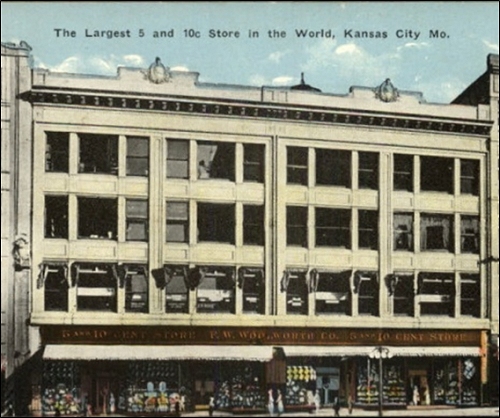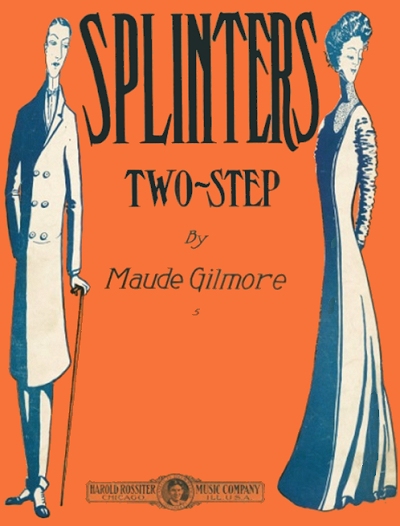Maude Gilmore was the elder of the two Gilmore sisters born in Kansas City, Kansas, to Marshall E. Gilmore and Rose Lee Anderson. Her other siblings included her fraternal twin Frank (7/1890) and younger sister Mary Ethel (5/20/1892). Her name was inspired by the oft-parodied 1856 poem of the same name by John Greenleaf Whittier. "Maud Muller, on a summer's day, raked the meadow sweet with hay." The 1895 Kansas census listed Marshall as a laborer, and in 1900 he was a painter working in a railroad car barn, a job he would hold for at least the next decade.
The 1895 Kansas census listed Marshall as a laborer, and in 1900 he was a painter working in a railroad car barn, a job he would hold for at least the next decade.
 The 1895 Kansas census listed Marshall as a laborer, and in 1900 he was a painter working in a railroad car barn, a job he would hold for at least the next decade.
The 1895 Kansas census listed Marshall as a laborer, and in 1900 he was a painter working in a railroad car barn, a job he would hold for at least the next decade.According to historian Nora Hulse, neither sister had much more than basic musical training. However, both became professional pianists and organists in their teens. Maude obtained a job as a sheet music demonstrator at the F.W. Woolworth 5 and 10 Cent Store across the state line at 11th and Main in downtown Kansas City, Missouri, which was the same intersection as the S.S. Kresge five and dime where her sister Mary would eventually take the same position. In the May, 1999, issue of the Rag Times, editor and ragtime historian Richard Zimmerman speculates that the illustration on the cover of composer Euday Bowman's moderately successful 11th Street Rag is no less than Maude playing in a second floor window for customers dancing in front of the Woolworth store. A 1910 postcard of the building bears out that probability.
Maude's nickname, for whatever reason, was "Slivers." So her first piano rag bore that title, and was published by family friend and well-known composer and publisher Charles L. Johnson. The traditional story has been that there was a regional baseball player who also went by the nickname of "Slivers," but it was actually the circus clown, Frank "Slivers" Oakley, who had a pantomime baseball act playing on the Orpheum circuit around 1908. Oakley made some legal noise about the title infringing upon his name, and Johnson capitulated by re-releasing the rag under the title Splinters in 1909. (Oakley never made it as big as he had hoped, and after failing in vaudeville took his own life in 1916.) That success was followed by Peach Blossoms in 1910, another fine piano rag.
Maude's twin brother Frank died in 1910 at 19 years of age just before the census, which showed both sisters as a piano player in a store, and still living with their parents on the Kansas side of the line. To commemorate the life and loss of Frank, Maude dedicated her 1912 composition Lorelei: A Reverie to his memory. That same year local composer and publisher Louis Weber, who may have been sweet on Maude, issued Sweet Memories, a parlor piece dedicated to Miss Gilmore. Her heart, however, was set on another man.
That same year local composer and publisher Louis Weber, who may have been sweet on Maude, issued Sweet Memories, a parlor piece dedicated to Miss Gilmore. Her heart, however, was set on another man.
 That same year local composer and publisher Louis Weber, who may have been sweet on Maude, issued Sweet Memories, a parlor piece dedicated to Miss Gilmore. Her heart, however, was set on another man.
That same year local composer and publisher Louis Weber, who may have been sweet on Maude, issued Sweet Memories, a parlor piece dedicated to Miss Gilmore. Her heart, however, was set on another man.In early 1913 Maude married pharmacist Ovid Leonnell Johnson in Kansas City, Kansas. It was perhaps more than a coincidence that Ovid was a partner to Walton Bodine, whom Mary Gilmore would marry the following year. Their daughter Dorothy L. was born late in the year, and Ruth Irene in 1917. Shortly after each daughter was born Maude was back in the theater and her piano, and likely not her demonstrator day job any more. She would need that skill to survive a rough patch, as Ovid was taken by the Spanish Flu pandemic of 1918 while at Fort Riley in Kansas.
After a year Maude married casket builder Ross J. Evans on November 1, 1919. He was a partner in the Rex-Art Casket Company of Kansas City, Kansas, which he helped to run into the early 1960s. The 1920 census showed the newly blended family living in Kansas City, Kansas, where they would remain for the next decade. Maude continued to play for theaters, and even got Ross into the act, coaching him and his baritone voice into a passable singer. However, he never made it at a professional level.
Later in the decade Maude obtained a job as a staff organist and pianist for station WLBF on the Missouri side of the line [present day KCKN, 1340 AM], which had gone on the air in 1926. Maude would take phone and mail requests for songs when she played from 10:00 PM to 11:00 PM several nights a week. Her other shows included an organ hour in the 1930s, and remotes from the Granada Theater, as well as the Sunday "Angelus Hour." Her theme song was Play That Dreamy Melody by Ted Koehler and Frank Magine. It is entirely probable that in the late 1930s she helped her nephew, Walton Bodine, Jr., get a job in broadcasting, which he kept for many years.
While there was success on the radio for Maude, there was not so much at home. In the early 1930s she divorced Ross. In 1934 she married a singer she had worked with, Missouri native Hiram Murphy, who had been performing opera in New York City and other locations. From that point on she used the name Maude Gilmore Murphy on the air and elsewhere.
According to family information relayed by Nora Hulse, Maude was active in a number of musical organizations geared towards women, including the McDowell Club, the Mozart Club, and the Kansas City Chapter of the American Guild of Organists. She also gave piano lessons in her home in later years. The 1940 census showed the Murphys living in Kansas City, Kansas, with Hiram working as a railroad car repairman. By the time of the 1950 record he was the car shop foreman. Maude kept her skills up, teaching into her sixties, and was ready and willing to play challenging pieces like Cannon Ball, Maple Leaf Rag, or Splinters, even into her seventies. She continued as an organist at her church until she was around 79 years old. Maude Gilmore Murphy passed on in 1971 just three days after her 91st birthday, and on the cusp of the great ragtime revival of the 1970s when her name and her work would once again start to gain much earned recognition in Kansas City.
Some of the information for this article was culled from the Ragtime Ephemeralist, Volume 3, article on women composers by Nora Hulse and Nan Bostick. The rest was taken from government and public records, as well as newspaper accounts and notices.
 Known Compositions
Known Compositions